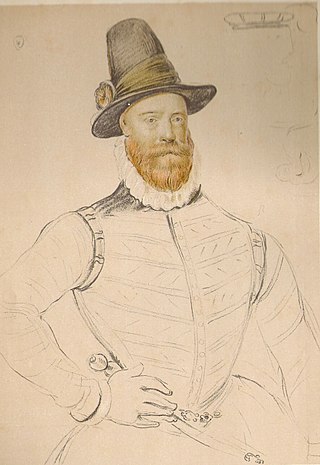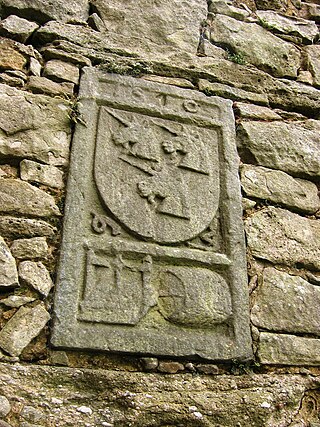Background
He was the eldest of son of Alexander Hamilton (died 1547) and Catherine Hamilton, a daughter of John Hamilton of Newtoun. Newtoun or Newton lies just south of Strathaven.

Andrew Hamilton of Goslington, Newton, and Silvertonhill (died 1592) was a Scottish landowner.
He was the eldest of son of Alexander Hamilton (died 1547) and Catherine Hamilton, a daughter of John Hamilton of Newtoun. Newtoun or Newton lies just south of Strathaven.

Andrew Hamilton of Goslington and his brother John Hamilton of Newtoun helped to hold Craignethan Castle against Mary, Queen of Scots and Lord Darnley during the Chaseabout Raid rebellion in 1565. They were forgiven in a royal remission of 2 January 1566. [1]
James Hamilton, 3rd Earl of Arran had been imprisoned in Edinburgh Castle as a suspect traitor. He suffered from mental health issues. In 1566 he was allowed to live at Hamilton Castle. A number of members of the Hamilton family, including Andrew Hamilton of Goslington, undertook to be "cautioners" for his good behaviour. [2]
Andrew Hamilton of Goslington was at Hamilton before the battle of Langside on 8 May 1568, and his name, as "Silvertoun knight" appears on the bond signed by Mary's supporters. [3] He was forfeited for treason by Regent Moray in Parliament in Edinburgh on 19 August 1568 for his support of Mary, Queen of Scots, after her escape from Lochleven Castle, having fought for her at the battle of Langside. [4]
In July 1570, he was accused with Claud Hamilton and others, of making plans to ambush Regent Lennox and the Earl of Mar in Callender Wood. [5] John Hamilton, Archbishop of St Andrews denied his own involvement in this plan during his trial in April 1571. [6]
In March 1575 Andrew's brother, John Hamilton, was among the Hamiltons who made peace with Regent Morton on the issue of a murder in March 1575 at Holyroodhouse, after handing their swords to the Captain of Edinburgh Castle, George Douglas of Parkhead. [7]
In 1579 the Hamiltons were suppressed for their support for Queen Mary, and for the murders of Regent Moray and Regent Lennox. The family fortified their houses and castles. On 18 May 1579, Sir James Hamilton younger (of Libberton) helped the King's forces take Craignethan Castle. According to the contemporary historian David Moysie, he won the castle 'upone ane accident'. Hamilton (Cadzow Castle) was bombarded by royal gunner Michael Gardiner, and fell on 19 May. [8] "John Hamilton of Sillertoun" was captured at Hamilton, regarded with others as a suspect in the deaths of the Regents. Caution or bail was found for Andrew Hamilton of Goslington, who like his brother, had remained loyal to the leaders of the Hamilton family. Hamilton of Libberton was requested by the Privy Council of Scotland to demolish or slight Craignethan, a castle built by his grandfather James Hamilton of Finnart. [9]
Andrew Hamilton's wife's name is unknown. Their children included:

The Battle of Langside was fought on 13 May 1568 between forces loyal to Mary, Queen of Scots, and forces acting in the name of her infant son James VI. Mary’s short period of personal rule ended in 1567 in recrimination, intrigue, and disaster when, after her capture at Carberry Hill, she was forced to abdicate in favour of James VI. Mary was imprisoned in Lochleven Castle, while her Protestant half-brother, James Stewart, Earl of Moray, was appointed Regent on behalf of his nephew. In early May 1568 Mary escaped, heading west to the country of the Hamiltons, high among her remaining supporters, and the safety of Dumbarton Castle with the determination to restore her rights as queen. Mary was defeated and went into exile and captivity in England. The battle is generally considered the start of the Marian civil war.

James Douglas, 4th Earl of Morton was a Scottish nobleman. He played a leading role in the murders of Queen Mary's confidant, David Rizzio, and king consort Henry Darnley. He was one of the last of the four regents of Scotland during the minority of James VI and I. He was in some ways the most successful of the four since he won the civil war that had been dragging on with the supporters of the exiled Mary, Queen of Scots. However, he came to an unfortunate end, executed by means of the Maiden, a predecessor of the guillotine.

Craignethan Castle is a ruined castle in South Lanarkshire, Scotland. It is located above the River Nethan, a tributary of the River Clyde, at NS816464. The castle is two miles west of the village of Crossford, and 4.5 miles north-west of Lanark. Built in the first half of the 16th century, Craignethan is recognised as an excellent early example of a sophisticated artillery fortification, although its defences were never fully tested.

James Hamilton of Bothwellhaugh and Woodhouselee was a Scottish supporter of Mary, Queen of Scots, who assassinated James Stewart, 1st Earl of Moray, Regent of Scotland, in January 1570. He shot Moray from the steps of his uncle Archbishop John Hamilton's house in Linlithgow.
William Baillie, Lord Provand was a Scottish judge from Lamington.

Simon Preston of Craigmillar was Provost of Edinburgh during the years 1565 to 1569 and was a member of the Privy Council of Scotland during the reign of Mary, Queen of Scots.
Robert Sempill, 3rd Lord Sempill was a Scottish lord of Parliament.

The Marian civil war in Scotland (1568–1573) was a period of conflict which followed the abdication of Mary, Queen of Scots, and her escape from Lochleven Castle in May 1568. Those who ruled in the name of her infant son James VI fought against the supporters of the Queen, who was exiled in England. Edinburgh Castle, which was garrisoned in her name, became the focus of the conflict and surrendered only after an English intervention in May 1573. The conflict in 1570 was called an "intestine war in the bowels of this commonwealth", and the period was called soon after an "intestine war driven by questions against authority."
Patrick Lindsay, 6th Lord Lindsay of the Byres, (1521–1589), Scottish courtier and Confederate lord.
Servais de Condé or Condez was a French servant at the court of Mary Queen of Scots, in charge of her wardrobe and the costume for masques performed at the Scottish royal court.

Boghall Castle was a 14th-century castle to the south of Biggar, South Lanarkshire, Scotland. Boghall became ruinous in the 19th century.
Michael Gardiner was a Scottish artilleryman based at Stirling Castle. The surname also appears as Gardner and Gardenar.
John Acheson was a Scottish goldsmith, mining entrepreneur, and official of the mint.
Robert Anstruther was a Scottish soldier in the service of Mary of Guise and Mary, Queen of Scots.
Marie Pieris, Lady Seton was a French lady in waiting at the Scottish court.
Robert Colville of Cleish (1532–1584) was a Scottish courtier.
Alexander Durham was a Scottish courtier and administrator.
Henry Wardlaw of Torrie was a Scottish landowner and courtier.

James Stewart (1566–1625), son of Mary, Queen of Scots (1542–1587) and Lord Darnley (1546–1567), was crowned King of Scotland by Adam Bothwell, Bishop of Orkney, in the Holy Rude Kirk at Stirling on 29 July 1567.
George Auchinleck of Balmanno was a Scottish courtier and servant of Regent Morton in the 1570s.